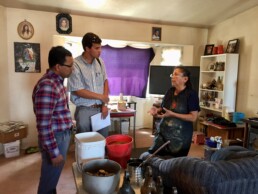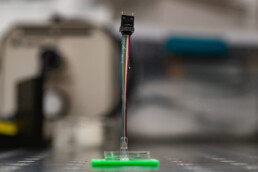by Nat Levy
It’s been a busy year of research innovation in our Texas Engineering community. In the Cockrell School, researchers identify the biggest problems facing our society and take unique approaches to solve them.
A common theme among innovations so far this year is water. Several researchers have tackled the challenge of creating clean, drinkable water for people facing disasters or lacking access in general. Read to learn more about these projects as well as several other major research breakthroughs that have happened this year.
When there’s a deep freeze like the one that hit Texas in 2021 — a more than weeklong historical weather event that shut down the entire state of Texas as well as several neighboring areas — many people can be left without options for drinking water for extended time due to frozen pipes. One Texas Engineer hopes to change that with a new device that can quickly turn water from lakes or creeks into drinkable water. The mug-sized device, using a small jolt of electricity to fish out bacterial cells, removed 99.997% of E. coli bacteria from 2- to 3-ounce samples taken from Waller Creek in Austin in approximately 20 minutes, with the capacity to do more. The key to the device, says project leader Donglei Emma Fan from the Walker Department of Mechanical Engineering is a “branched” electrode that her team created for a previous project. The patented electrode’s structure is based on a root system in a tree with branches traveling in several directions. When electrified, the device creates a field that the E. coli cells are attracted to. They willingly “swim” into the electrode branches.
“We are able to clean water using very little energy because we steer the bacterial cells with electric fields, and most bacterial cells are natural swimmers who propel themselves to electrodes and got captured alive.”
— Donglei Emma Fan, professor, Walker Department of Mechanical Engineering
The Navajo Nation, like other native communities across the U.S., lacks access to clean drinking water. The community also harbors mistrust toward some traditional solutions. To bridge this trust gap, a team led by Navid Saleh, a professor in the Fariborz Maseeh Department of Civil, Architectural and Environmental Engineering, blended local materials with water filtration technology to develop a new option. The researchers lined Navajo-made clay pots with pine tree resin collected from the area and incorporated tiny, silver-based particles that can be used to purify water to make it drinkable. They worked closely with a third-generation potter from Arizona — Deanna Tso, who is also a co-author on the paper — to create a device that is simple for the users. All they have to do is pour water through the clay pots; the coated pottery removes any bacteria and generates clean, drinkable water.
“Making water filtration technology cheap doesn’t solve all the problems, and making it effective doesn’t solve everything either. You have to think about the people you are making it for.”
— Navid Saleh, professor, Fariborz Maseeh Department of Civil, Architectural and Environmental Engineering
Inspired by the environmental calamity of the Deepwater Horizon incident, mechanical engineer Guihua Yu led a team that developed a new method to clean up oil spills. The new technology uses a dual-layer mesh roller coupled with induction heating technique, with material properties that allow it to separate oil from water and then remove that oil from the ocean with extremely high efficiency and throughput. In experiments, the researchers showed the potential to retrieve up to 1,400 kilograms of viscous oil per square meter per hour, which is about 10 times better than the way oil is cleaned up today. These rollers would be attached to boats and dragged across a spill area, where they could complete cleanup operations in a day or two, compared to the weeks-long efforts that current techniques require.
“When you have a widespread oil spill in the ocean, it slowly diffuses into the water, so how quickly and efficiently you can retrieve the oil has a major impact on the marine environment.”
— Guihua Yu, professor, Walker Department of Mechanical Engineering
As the virus that causes COVID-19 has evolved over the years it has become harder and harder to tell it apart from other illnesses with similar symptoms. For several years, a Texas Engineering team led by Ray Chen from the Chandra Family Department of Electrical and Computer Engineering has been developing a diagnostic platform able to differentiate between COVID and the flu. The latest entry in this quest is a new “lab-on-a-chip” testing sensor that builds on a silicon complementary metal oxide semiconductor-compatible, photonic chip-based platform Chen and his team previously developed. The overall goal is to provide lab-quality diagnostics, while shrinking them down to a portable size so they can reach people in isolated areas.
“Though COVID isn’t top of mind for most of us like in 2020, emergence of new variants has made it increasingly challenging to differentiate it from other infectious diseases with similar symptoms, such as the common cold and seasonal flu.”
— Ray Chen, professor, Chandra Family Department of Electrical and Computer Engineering
In a creative use of existing technology, researchers modified a virtual reality headset to serve as a device that monitors brain activity in a noninvasive way. Led by Nanshu Lu, from the Department of Aerospace Engineering and Engineering Mechanics, the researchers developed a series of electroencephalogram (EEG) sensors made of soft, spongy electrodes that they installed throughout a Meta VR headset that can be worn comfortably for long periods. The EEG measures the brain’s electrical activity during the immersive VR interactions. The device could be used in many ways, from helping people with anxiety, to measuring the attention or mental stress of aviators using a flight simulator, to giving a human the chance to see through the eyes of a robot.
“Virtual reality is so much more immersive than just doing something on a big screen. It gives the user a more realistic experience, and our technology enables us to get better measurements of how the brain is reacting to that environment.”
— Nanshu Lu, professor, Department of Aerospace Engineering and Engineering Mechanics

